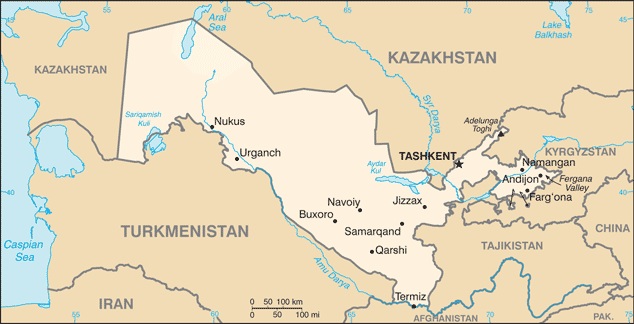The president of Uzbekistan, Shavkat Mirziyayev, has issued a draft of the decree “The Strategy for the Further Development of Uzbekistan”. In this draft it is expected to entrust the ministries and agencies to develop a plan for delimitation and demarcation of the state border with the neighboring republics in the first quarter of the year. This document must provide the acceleration of the process of legal registration of the uncoordinated state border with Kyrgyzstan, Kazakhstan, Tajikistan and Turkmenistan. (Source: strategy regulation- UZBEK)
Comment:
The disputes, escalated sometimes into the armed confrontations due to the joint borders with the neighboring republics in the last period of Islam Karimov’s reign, were of a daily problem for Uzbekistan. Karimov, who managed to stay at the helm of government in Uzbekistan for a long time balancing in subordination to the West or Russia, held the pressure of the neighbors on the borders.
The borders of today’s existing republics of Central Asia appeared in 20-30s of the last century, based on a national basis after the capture of these territories by the communist regime, were drawn approximately. But after the collapse of the Soviet Union in the ‘90s, there appeared five republics of Central Asia on the basis of these borders. And after the power in each of these republics gained its own patron in the face of a large state, each of them began to define the borders of their possessions. Uzbekistan is in the middle of these republics and has the joint borders with them.
During Karimov’s rule, Russia was constantly trying to strengthen its influence in Uzbekistan. And when Russia failed to make arrangements with Karimov, it used one of the ways of pressuring on Uzbekistan – the joint borders that are on the transboundary rivers. Uzbekistan needs for water resources, used for irrigation of fields. For example, Russia initiated the construction of hydroelectric power station (HPS) and signed an agreement with Kyrgyzstan on the construction and operation of Kambarata HPS-1 on the Naryn River in 2009. The construction was started, but never finished. A similar example was with the construction of the Rogun HPS on the Vakhsh River in Tajikistan. This project had been launched in the USSR, but then it was mothballed. And in 2004, with the filing of the same Russia, the construction of the Rogun HPS was resumed, and eventually, stopped. Karimov repeatedly stated that water and energy problems in Central Asia in the future “may be exacerbated to the extent that they cause not only a serious confrontation, but even wars”.
And now оn taking office, the new president of Uzbekistan, quickly stopped the disputes about the borders, that lasted for years, and issued a decree on the settlement of the disputes on the joint borders with all his neighbors. Most likely, Shavkat Mirziyayev, being loyal to the policy of Russia, does not see the threats, which Islam Karimov feared and has opened his arms to Russia. Mirziyayev makes concessions to the Kremlin, and the Kremlin in turn, having received the desired, will make concessions to Mirziyayev and solve all his claims on water resources.
Thus, the disbelieving colonizers, whether from the West or Russia, use the borders drawn by themselves only to achieve their own selfish goals. And the strengthening of the borders of Uzbekistan and neighboring countries means the strengthening of the power of a colonialist presence in our lands. Since the proclamation of the so-called “independent republic” nothing has changed in the country. None of these countries have become independent, on the contrary. Freed from the colonizer in the face of the communist regime of the USSR, they passed into the subordination of the Russian dictatorship or the Western colonizers, remained practically satellite-states.
These republics will receive freedom and independence only after abolishing their borders based on ethnic grounds and unite into a single whole, into one Islamic Ummah. This entire area was once part of the great and mighty Khilafah State (Caliphate). From time immemorial, the peoples of these republics are Muslims and the culture of these peoples is inextricably linked with Islam. Allah سبحانه وتعالى says in His Glorious Book:
يَا أَيُّهَا النَّاسُ إِنَّا خَلَقْنَاكُم مِّن ذَكَرٍ وَأُنثَى وَجَعَلْنَاكُمْ شُعُوبًا وَقَبَائِلَ لِتَعَارَفُوا إِنَّ أَكْرَمَكُمْ عِندَ اللَّهِ أَتْقَاكُمْ إِنَّ اللَّهَ عَلِيمٌ خَبِيرٌ
“O mankind, indeed We have created you from male and female and made you peoples and tribes that you may know one another. Indeed, the most noble of you in the sight of Allah is the most righteous of you. Indeed, Allah is Knowing and Acquainted”.
(49:13)
Eldar Khamzin
Member of the Central Media Office of Hizb ut Tahrir

